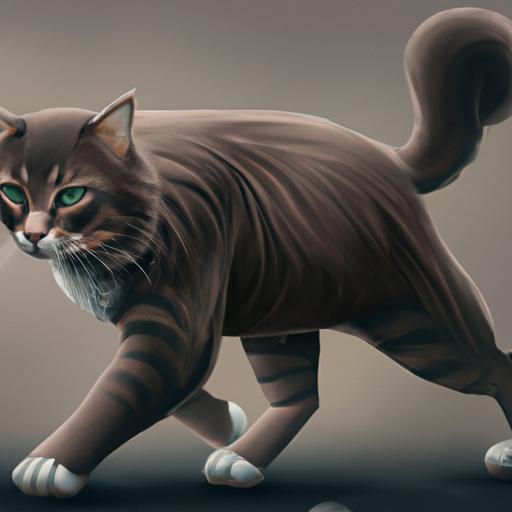If you have a cat, you know that they can be a joy to have around, but sometimes they can cause a bit of damage to your furniture.
You may be wondering if declawing your cat is an option in Ontario.
In this article, we will answer all your questions about declawing cats in Ontario, including what it involves, the alternatives to declawing, the risks and complications, and the stance of the Ontario Veterinary Medical Association (OVMA).
So, read on to find out everything you need to know about declawing cats in Ontario.
Table of Contents
Can You Get Cats Declawed In Ontario?
Yes, cats can be declawed in Ontario.
This is a procedure that is done by a veterinarian and involves the surgical removal of the cat’s claws.
It is a controversial procedure and should be discussed with a veterinarian before proceeding.
What Does Declawing Involve?
Declawing cats is a controversial procedure that can cause long-term complications for cats.
It involves surgically removing the claws and the last knuckle of the toe, and is usually done under general anesthesia.
While it can help protect furniture and prevent cats from injuring their owners, it can also have serious consequences for cats that undergo the procedure.
The declawing process is a major surgical procedure that typically takes about 15 minutes.
Cats that are declawed may experience some pain and discomfort after the surgery, and should be monitored closely for signs of infection or other complications.
Additionally, declawing can lead to long-term issues such as chronic pain, infection, lameness, and behavioral changes such as aggression, biting, and excessive licking of the paws.
If you are considering declawing your cat, it is important to weigh the potential benefits against the risks.
Talk to your veterinarian about the procedure and any potential complications that could arise.
Its also important to consider alternative methods of protecting your furniture and preventing your cat from injuring you, such as providing them with scratch posts and trimming their nails regularly.
Declawing cats is a complex issue, and one that should not be taken lightly.
It is important to research the procedure thoroughly and discuss your concerns with a veterinarian before making a decision.
What Are the Alternatives to Declawing?

Cats are known for their mischievousness and sharp claws, which can often lead to scratches and damage to furniture and other items in the home.
To help prevent this, there are some measures that can be taken to protect furniture and other items from being scratched.
Regular nail clipping is an important part of keeping cats nails short and less likely to cause damage.
Clipping the nails of cats can help keep them from scratching and damaging furniture.
This should be done regularly to ensure that the nails remain short and sharp.
Providing suitable scratching posts is another way to help protect furniture and other items from being scratched.
Scratching posts provide cats with a place to exercise their natural instinct to scratch, as well as providing a claw-sharpening tool.
Other objects such as toys, boxes, and cardboard tubes can help keep cats entertained and away from furniture.
Soft Paws are vinyl nail caps that can be placed on cats’ claws, which help protect furniture and other items from being scratched.
Bitter sprays can also be used to discourage cats from scratching furniture and other items.
Positive reinforcement can be used to train cats to use their scratching posts and other acceptable objects instead of furniture and other items.
This can include providing treats when cats use their scratching posts and withholding treats when they scratch furniture and other items.
Regular trimming of cats’ claws can also help protect furniture and other items from being scratched.
Alternatives to declawing include nail clipping, providing scratching posts, and other objects.
In conclusion, there are various measures that can be taken to protect furniture and other items from being scratched by cats.
Regular nail clipping and providing suitable scratching posts are two of the most effective measures, but alternatives such as soft paws, vinyl nail caps, and bitter sprays can also be used.
Behavioral training and behaviour modification can also help to prevent cats from injuring their owners.
What Are the Risks and Complications Involved with Declawing?
Declawing cats is a surgical procedure that has been the subject of much debate, as the risks and complications associated with the procedure can be serious.
While declawing can provide a solution to unwanted scratching, cats may suffer from a number of potential complications including infection, nerve damage, and chronic pain.
Additionally, cats may experience behavioral changes, such as increased aggression and avoidance of the litter box.
Declawing is a major surgery that carries a number of risks and potential complications.
According to the Ontario Veterinary Medical Association, these can include infection, nerve damage, bleeding, and pain.
There is also a risk of long-term behavioral changes, such as increased aggression, biting, and avoidance of the litter box.
Cats may also suffer from chronic pain or lameness following the surgery.
It is also possible that the procedure could lead to a decrease in the cat’s quality of life.
Therefore, it is important for cat owners to be aware of the potential risks and complications associated with declawing.
While it is a viable solution to unwanted scratching, it is important to weigh the risks and benefits of the procedure before making a decision.
If you are considering declawing your cat, it is important to discuss the procedure with your veterinarian to ensure that you understand the risks and potential complications.
What Does the Ontario Veterinary Medical Association (OVMA) Say About Declawing Cats?

The Ontario Veterinary Medical Association (OVMA) is a professional organization for veterinarians in Ontario and has published an informative position paper on the subject of declawing cats.
The OVMA strongly discourages the practice of declawing cats and encourages alternatives such as regular nail clipping and providing suitable scratching posts and other objects.
The OVMA states that declawing should only be done after all other options have been explored and recommends that owners should consider the long-term implications, including the potential for the cat to experience pain and other issues related to the surgery.
The OVMA also discourages the practice of declawing cats that are younger than six months of age, and recommends that the surgery should be done by a qualified veterinarian with the use of anesthesia and pain relief medications.
The OVMA also publishes a list of frequently asked questions about declawing cats, which can be found on their website.
It is important to carefully consider the implications of declawing before deciding to go ahead with the procedure.
Alternatives such as regular nail clipping and providing suitable scratching posts and other objects should be explored first.
If the procedure is deemed medically necessary, the OVMA recommends that it should only be done with the use of anesthesia and pain relief medications, and that it should be done by a qualified veterinarian.
Where Can I Get My Cat Declawed in Ontario?
Declawing cats is an elective surgical procedure that is available in Ontario, but should only be done with the permission of the pet owner and after all other options have been explored.
The procedure involves the removal of the claws and the last knuckle of the toe and is typically done to protect furniture and other items in the home and to prevent cats from injuring their owners.
The Ontario Veterinary Medical Association (OVMA) strongly discourages the practice of declawing cats and instead encourages other methods, such as regularly clipping a cat’s nails and providing suitable scratching posts and other objects for them to scratch on.
The OVMA also maintains a list of veterinarians in Ontario who are willing to perform the surgery on cats.
The cost of the procedure may vary depending on the vet and the cat’s age and health condition.
After the surgery, the cat may require a period of rest and recovery.
The vet may prescribe pain medications and antibiotics to help with the healing process.
Some animal welfare organizations, such as the SPCA, may offer discounted rates for declawing cats.
Declawing cats is a major decision that should not be taken lightly.
If you are considering declawing your cat, it is important to speak to your veterinarian about all of the risks and alternatives first.
This can help ensure that your cat is receiving the best care possible and that you are making an informed decision.
Final Thoughts
Declawing cats, an ethically controversial practice, is allowed in Ontario with the permission of a veterinarian.
However, the Ontario Veterinary Medical Association (OVMA) strongly discourages the procedure and encourages alternatives such as regular nail clipping and providing suitable scratching posts and other objects.
If you are considering declawing your cat, it is important to weigh the risks and benefits and to explore all available alternatives.
Ultimately, it is your responsibility to make the best decision for you and your pet.

